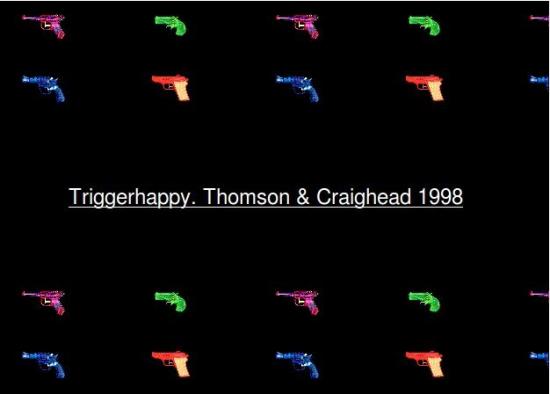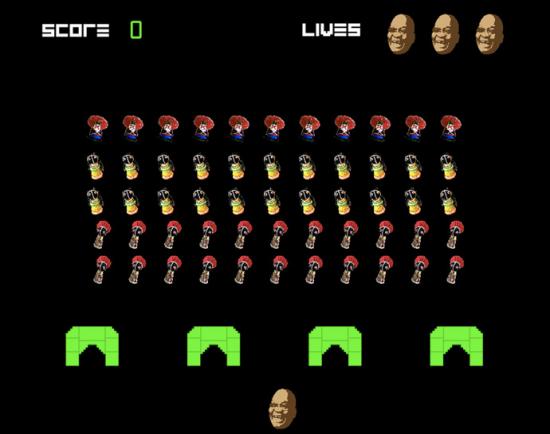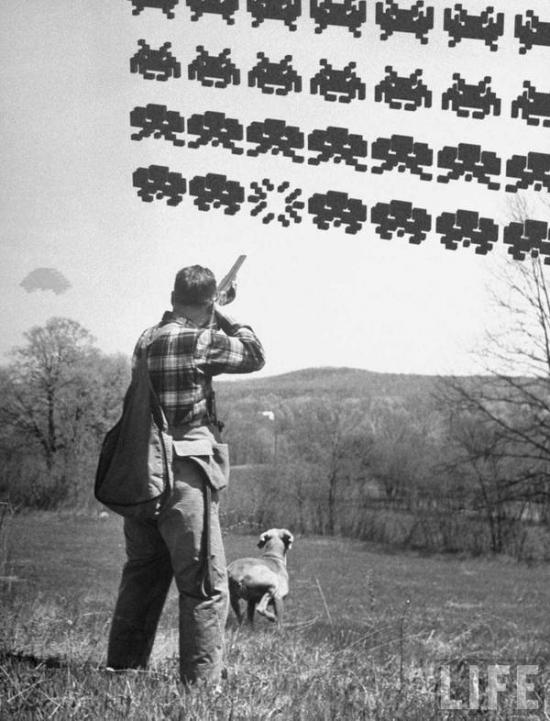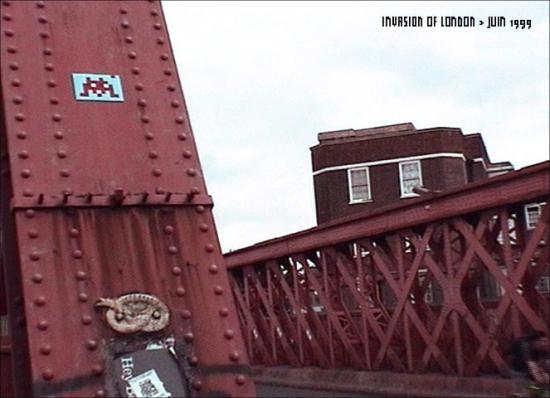



Videogame appropriation in contemporary art: Space Invaders
Tomohiro Nishikado’s classic videogame Space Invaders from 1978 can be seen as a metaphor for the Cold War and the fears for an approaching nuclear war. An extraterrestrial army are marching rhythmic and increasingly closer to Earth. Only a lone cannon stands between the intergalactic monsters and the total annihilation of mankind. The lonely hero struggling against evil is a theme that we recognise from myths, films and books. Space Invaders with its clear and pedagogical symbolic language has inspired several contemporary artists to describe the eternal struggle between good and evil in our time.

In the British artists Thomson & Craighead version Triggerhapppy the enemy aliens are replaced with quotes taken from the French philosopher Michael Foucault’s essay “What is an author?” “Triggerhappy” is a work that explores the relationship between hyper-text, author and reader. What is a writer, or rather, who is the artist when we are dealing with interactive art in the form of a videogame? Is it Tomohiro Nishikado who created the original game or is it Thomson & Craighead that have modified the game or the player that are playing the game or maybe the computer that creates and interprets the text (the code) that make the game appear on the screen?

After the 11th of September the world suddenly saw a new major enemy, international terrorism. In a modernized version of “Space Invaders”, the artist Douglas Edric Stanely located the scenario in the game to the Twin Towers in New York, which was destroyed during the terrorist attack on 11th September 2001. In Stanley’s version titled the invaders, you have to fight against the hostile aliens before they completely destroy the two towers. The classic struggle between good and evil continues, the game concept is the same as in the original but the scenario and the metaphoric meaning of the aliens has changed.

The struggle between good and evil can also be found in other areas of our society, for example in class and gender struggle. In the South African photojournalist Nadine Hutton’s version Skirt-Invaders the main character in the game is Jacob Zuma, South African president since 2009. Zuma has been quite controversial because he is a polygamist and has expressed his doubt about the dangers of AIDS. In the game Zuma you have to shoot down a never-ending stream of virgins from the Zulu tribe. Will the president succeed to shoot down any threatening scandals before they land on the ground? Hutton’s work is an example how a well-known videogame can be used for political purposes and be both entertaining and still very critically at the same time.

The term mash-up, which is frequently used today, could be described as a form of digital collage. Ryan Sneider has created mash-ups by combining images from various sources, in this case photographs from Life magazine’s archives and videogames. The photomontage Duck Hunt / Space Invader shows a bird hunter with a dog, but it is not birds the hunter aims for, instead it is the famous monsters from the “Space Invaders”. Those who played videogames in the 70 – and 80’s will probably remember the game “Duck Hunt”, where you could shoot ducks that flew up out of the reeds and your faithful dog then ran to fetch them. Sneider has combined the two game ideas, one composed of a photo of a true hunter with a dog and the second of digital graphics from the videogame “Space Invaders”. The work discusses the boundaries between the real and digital world. What will happen when these two worlds become more integrated and the borders are increasingly blurred?


Finally we have to mention the artist, who personifies the game, the French street artist who hides behind the pseudonym Space Invader. His main art project consists of invading various cities around the world and putting up small mosaics of characters from videogames as “Space Invader”. For each successful invasion, he collects points, and the whole art project is described on his website as a reality game. Like other forms of street art “Space Invader” is an ongoing battle about the public space. With help of popular culture Space Invader tries to infiltrate the commercial forces that almost have total monopoly on the imagery that appears in our public spaces. The aliens, in form of small mosaics, become a force that can not be defeated when they are spreading all over the world. A important part of the game “Space Invaders” is that you cannot win, you can certainly come to the high score list, but you can never defeat the aliens, they are instead coming in faster and faster each time they are shot down. It’s obviously a dystopian world view we meet in the videogame, but if we look at it from the artist Space Invaders point of view, it’s rather something positive. The art is a force that will not be stopped. The invasion has just begun and the struggle between good and evil continues…
Videogame appropriation in contemporary art: Pong. Part 1 by Mathias Jansson.
Videogame appropriation in contemporary art: Tetris. Part 2 by Mathias Jansson.